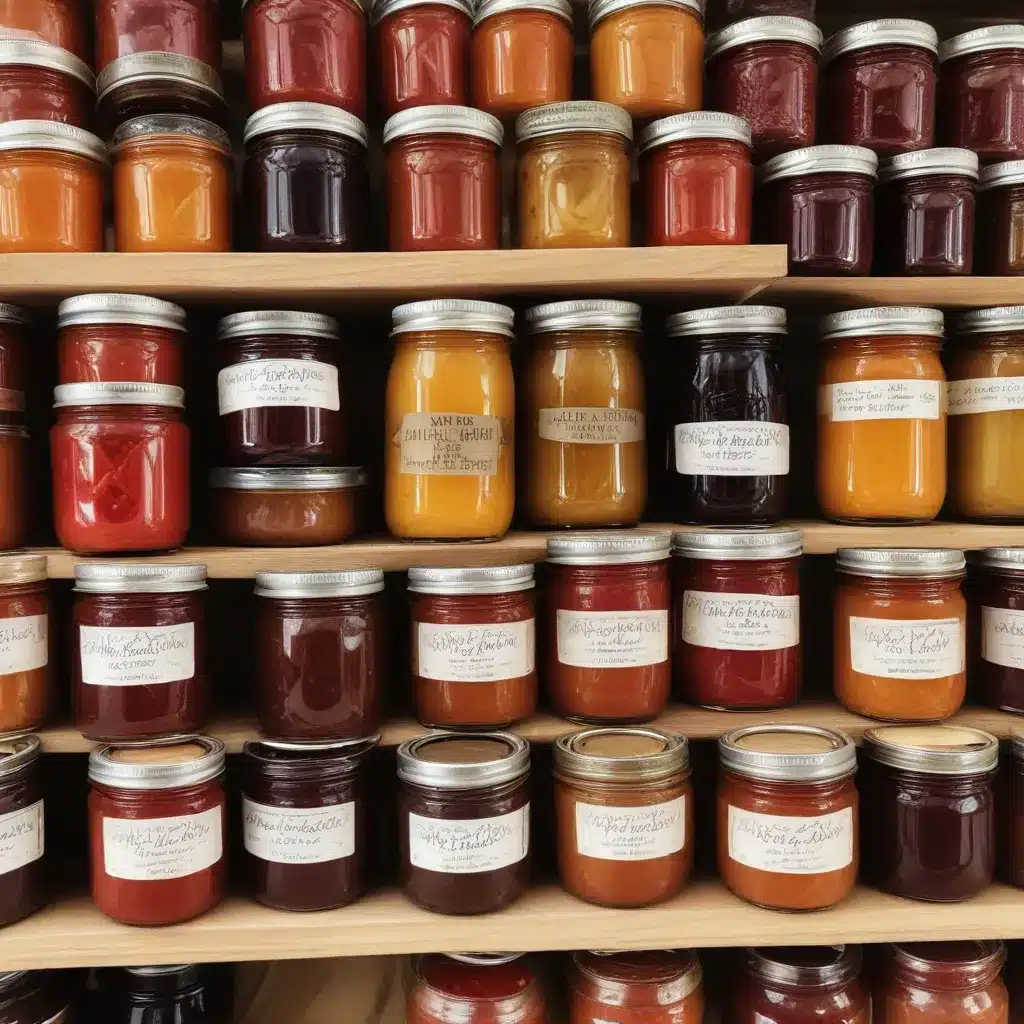
As a farm educator at Crooked Pines Farm, I’m always eager to share the joy of preserving our bountiful harvests. Preserving the peak flavors of summer and fall produce is a beloved homesteading tradition, allowing us to savor the seasons long after the growing period has ended. From jam-packed jars of ruby-red strawberry preserves to creamy, spreadable peach butter, there are so many delicious ways to capture farm-fresh goodness.
Preserves, Chutneys, and Fruit Butters: What’s the Difference?
Before we dive into the recipes, let’s clarify some key terms. When it comes to canned or jarred fruit products, there are a few main categories to know.
Jams are made by cooking down fruit pulp with sugar until thickened. They have a smooth, spreadable texture and typically contain small pieces of fruit.
Jellies are made from clear fruit juice and sugar, without any fruit solids. They have a firm, gel-like consistency.
Marmalades are a type of jam that contains citrus fruit, including the peel, which gives them a signature bitter-sweet flavor and slightly chunky texture.
On the chunkier side, preserves are made with larger pieces of whole or crushed fruit, cooked down with sugar. They have a more rustic, hearty mouthfeel.
Fruit butters are a type of preserve made by slowly simmering fruit pulp until it reaches a smooth, spreadable consistency, similar to nut butters. They often contain less sugar than jam.
Chutneys are fruit-based condiments that incorporate savory elements like onions, spices, and vinegar, creating a sweet-and-sour flavor profile.
The key differences come down to the fruit-to-sugar ratio, the texture, and the presence (or absence) of fruit solids. Understanding these nuances will help you choose the perfect preserve for your culinary needs.
Preserving Techniques for the Home Kitchen
Regardless of the preserve style, the basic process involves cooking down fruit with sugar until the desired thickness is achieved. From there, the mixture is ladled into jars and processed to create a shelf-stable product.
For water bath canning, the filled jars are submerged in boiling water for a specified time, killing any potentially harmful microbes. This method works well for high-acid foods like jams, jellies, and fruit butters.
Pressure canning, on the other hand, uses steam under pressure to sterilize the jars. This method is recommended for low-acid items that can’t be safely processed in a water bath. Chutneys and some fruit compotes may require pressure canning.
If you don’t want to invest in canning equipment, you can also opt to freeze your preserves. Simply pour the cooked fruit mixture into jars or freezer-safe containers and pop them in the freezer. This works great for jam, but the texture of butter and chutney may suffer a bit.
No matter which preservation route you choose, the key is to follow tested recipes and safety guidelines to ensure a long shelf life and safe consumption. Canning can seem daunting at first, but with a little practice, you’ll be a pro in no time.
Seasonal Fruit Preserves
When it comes to crafting homemade jams, preserves, and butters, the options are endless. Different fruits shine at various times of the year, offering a kaleidoscope of flavors to explore.
In the summertime, berries reign supreme. Strawberries, raspberries, blackberries, and blueberries all make wonderful preserves that capture the essence of sunny days. Try pairing them with a touch of honey or vanilla for a delightful spread.
As we transition into fall, stone fruits like peaches, nectarines, and plums take center stage. Their juicy flesh and subtle sweetness lend themselves beautifully to butters, chutneys, and more rustic-style preserves.
For the autumn harvest, apples, pears, and pumpkins deliver a wealth of preserving possibilities. An old-fashioned apple butter or a spiced pear preserve would be lovely alongside freshly baked scones or crackers.
No matter which seasonal gems you choose to preserve, the process is remarkably similar. The key is to select ripe, flavorful fruit at the peak of its season for the best results.
Preserving the Harvest: Recipes to Try
Ready to get your hands sticky with some homemade preserving magic? Here are a few of our favorite recipes to try:
Plum Preserves
With their vibrant hue and sweet-tart flavor, plums make an absolutely divine preserve. This recipe from French Creek Farmhouse walks you through the process, from selecting the perfect fruit to the canning steps. The rich, jammy texture pairs beautifully with biscuits, scones, or even savory cheese plates.
Sweet Cherry Jam
Capture the essence of summer with a batch of sweet cherry jam. This recipe from Tart Queen’s Kitchen shows how to utilize frozen cherries to enjoy this treat year-round. Spread it on toast, stir it into yogurt, or simply enjoy it by the spoonful.
Strawberry Honey Butter
For a decadent, spreadable delight, try your hand at strawberry honey butter. This luscious preserve from Azure Farm Life combines fresh berries, honey, and a touch of vanilla for a spread that’s equally at home on biscuits as it is swirled into oatmeal.
Peach Butter
Nothing captures the essence of a Crooked Pines summer quite like a batch of homemade peach butter. This recipe from The Prairie Homestead guides you through the slow-simmered process, resulting in a smooth, spreadable treasure. Enjoy it on toast, as a pancake topping, or stirred into yogurt.
Whether you’re new to preserving or a seasoned veteran, these recipes are sure to have your taste buds dancing with delight. So grab that basket of seasonal fruit, clear some counter space, and get ready to savor the flavors of the farm all year long.
And of course, don’t forget to visit Crooked Pines Farm for more delicious inspiration. From u-pick berry patches to farm-fresh produce, there’s always something new to discover and preserve at our bountiful oasis.


